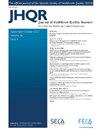Analysis of quality of life of patients with refractive errors in India
IF 1
Q4 HEALTH CARE SCIENCES & SERVICES
引用次数: 0
Abstract
Introduction
It is important to determine the health-related quality of life (HRQoL) to devise population-based cost-effective service delivery models. The present study aimed to evaluate the HRQoL of patients with refractive errors (RE) using generic and vision-specific instruments, identify the determinants of HRQoL, and examine the validity between the quality-of-life instruments for refractive errors.
Methods
Face-to-face interviews were conducted with 515 participants with RE using generic as well as vision-specific HRQoL measures. Mean EuroQol-five dimensions-five levels (EQ-5D-5L) utility value, National Eye Institute-Visual Function Questionnaire-25 (NEI-VFQ-25) composite score, and EuroQol-Visual analogue scale (EQ-VAS) score were computed, and determinants of quality of life were determined using generalized linear regression model. The validity between generic and disease-specific measures was ascertained using Pearson's coefficient.
Results
The mean EQ-5D-5L utility score for patients with RE was estimated as 0.72 (95% CI: 0.70–0.75). The mean NEI-VFQ-25 composite score and EQ-VAS score were 71.3 (95% CI: 69.8–73), and 74.7 (95% CI: 73.4–76.1), respectively. Visual acuity, gender, and presence of co-morbidities were significantly associated with quality of life. The concurrence between the generic and vision-specific instruments was found to be low to moderate.
Conclusion
The findings of the study indicate the importance of the value of quality of life for patients with RE, which could be taken into account by health administrators, doctors and researchers to carry out economic evaluations, since these measures provide a basis for an evaluation more precisely the impact of RE and guide the determination of efficient ways to alleviate the burden of treatable visual impairment.
More research is required to explore the potential integration of a vision component, the sixth dimension, into the EQ-5D-5L instrument, given the moderate agreement observed between the generic and specific assessment tools.
印度屈光不正患者的生活质量分析。
简介确定与健康相关的生活质量(HRQoL)对于设计基于人群的具有成本效益的服务提供模式非常重要。本研究旨在使用通用工具和视力特异工具评估屈光不正(RE)患者的 HRQoL,确定 HRQoL 的决定因素,并检验屈光不正生活质量工具之间的有效性:方法:采用通用的和视力专用的 HRQoL 测量方法,对 515 名屈光不正患者进行了面对面访谈。计算了EQ-5D-5L(EuroQol-five dimensions-five levels)效用值、NEI-VFQ-25(National Eye Institute-Visual Function Questionnaire-25)综合评分和EQ-VAS(EuroQol-Visual analogue scale)评分的平均值,并使用广义线性回归模型确定了生活质量的决定因素。结果显示,EQ-5D-5L 的平均值高于 EQ-VAS 的平均值,EQ-5D-5L 的平均值高于 EQ-VAS 的平均值:RE 患者的平均 EQ-5D-5L 实用性评分估计为 0.72(95% CI:0.70-0.75)。NEI-VFQ-25综合评分和EQ-VAS评分的平均值分别为71.3(95% CI:69.8-73)和74.7(95% CI:73.4-76.1)。视力、性别和是否合并其他疾病与生活质量密切相关。研究发现,通用工具和视力特异工具之间的吻合度为中低:研究结果表明了视力障碍患者生活质量价值的重要性,卫生管理者、医生和研究人员在进行经济评估时可以考虑到这一点,因为这些措施为更准确地评估视力障碍的影响提供了基础,并指导确定有效的方法来减轻可治疗视力障碍的负担。鉴于通用评估工具和特定评估工具之间的一致性一般,因此需要开展更多研究,探索将视觉部分(第六维度)纳入 EQ-5D-5L 工具的可能性。
本文章由计算机程序翻译,如有差异,请以英文原文为准。
求助全文
约1分钟内获得全文
求助全文
来源期刊

Journal of Healthcare Quality Research
Medicine-Health Policy
CiteScore
1.70
自引率
8.30%
发文量
83
审稿时长
57 days
期刊介绍:
Revista de Calidad Asistencial (Quality Healthcare) (RCA) is the official Journal of the Spanish Society of Quality Healthcare (Sociedad Española de Calidad Asistencial) (SECA) and is a tool for the dissemination of knowledge and reflection for the quality management of health services in Primary Care, as well as in Hospitals. It publishes articles associated with any aspect of research in the field of public health and health administration, including health education, epidemiology, medical statistics, health information, health economics, quality management, and health policies. The Journal publishes 6 issues, exclusively in electronic format. The Journal publishes, in Spanish, Original works, Special and Review Articles, as well as other sections. Articles are subjected to a rigorous, double blind, review process (peer review)
 求助内容:
求助内容: 应助结果提醒方式:
应助结果提醒方式:


